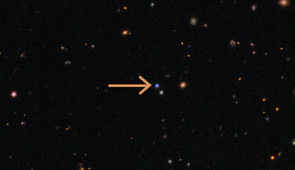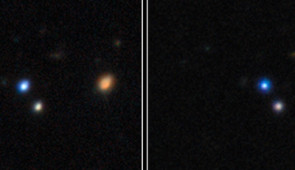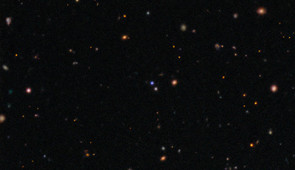
Supernova’s ‘trapped’ jet reveals source of fast X-ray transient
Mysterious cosmic explosion is traced to a massive stellar explosion
- Link to: Northwestern Now Story
EMBARGOED UNTIL 12 P.M. EDT (U.S.) ON MONDAY, JULY 7, 2025
- Fast X-ray transients (FXTs) are blasts of X-rays from distant galaxies
- Astronomers have detected FXTs since the 1970s, but their origins have remained unknown
- By studying the closest FXT associated with a supernova ever detected, scientists found it was produced by a geyser of high-energy particles trapped inside the outer layer of a massive star
EVANSTON, Ill. --- An international team of astrophysicists, led by Northwestern University and the University of Leicester in England, has uncovered a possible origin of fast X-ray transients (FXTs) — mysterious, fleeting bursts of X-rays that have long puzzled astronomers.
Using a combination of telescopes around the globe and in space, the team studied the closest FXT associated with the explosive death of a massive star, or supernova, ever observed. A geyser of high-energy particles, or jet, trapped inside a supernova produced the FXT, the scientists discovered.
When jets burst through a massive star’s onion-like layers, they generate gamma-ray bursts (GRBs), the most powerful and luminous explosions in the universe. When the jets are stifled, however, they emit lower levels of energy, which astronomers can detect only from X-ray signals. The new observations now point to these “failed” jets as a source of the emission, explaining the historically elusive phenomena.
This finding marks a significant step in understanding the diverse landscape of cosmic explosions — bridging the gap among FXTs, GRBs and supernovae. Two companion studies, detailing various aspects of the event, have been accepted by The Astrophysical Journal Letters. (Both papers are available on ArXiv: Rastinejad et. al. and Eyles-Ferris et. al.)
“Since the 1970s, astronomers have detected FXTs — blasts of X-rays from distant galaxies that can last from seconds to hours,” said Northwestern’s Jillian Rastinejad, who led one of the studies. “But their sources have remained a long-standing mystery. Our work definitively shows that FXTs can originate from the explosive death of a massive star. It also supports a causal link between GRB-supernovae and FXT-supernovae, in which GRBs are produced by successful jets, and FXTs are produced by trapped weak jets.”
“Our team — spread across time zones around the globe — enabled us to work around the clock to gather data, analyze it as soon as it was taken and hand off the results to the next time zone to make decisions on the next night of observations,” said Northwestern’s Wen-fai Fong, a senior author on both studies. “The result? A massive and beautiful stream of data collected from facilities large and small, on the ground and in space, chronicling this event’s first month. It takes really special events to motivate such a global effort, and this FXT was one.”
Rastinejad is a recent Ph.D. graduate in astronomy at Northwestern’s Weinberg College of Arts and Sciences and member of the Center for Interdisciplinary Exploration and Research in Astrophysics (CIERA). She is advised by Fong, an associate professor of physics and astronomy at Weinberg and member of CIERA. Rastinejad led a study focused on the supernova behind the FXT. A second companion study — led by Rob Eyles-Ferris, a postdoctoral researcher at the University of Leicester — focuses on the “trapped” jet.
An explosive neighbor
Although astronomers have detected FXTs for decades, the limited number of discoveries prevented detailed studies. But now, scientists have a new space-based tool, called the Einstein Probe, which is dedicated to the search. Launched in January 2024 by the Chinese Academy of Sciences in partnership with the European Space Agency and the Max Planck Institute for Extraterrestrial Physics, the Einstein Probe carries two scientific instruments, specially designed to observe X-ray sources.
“FXTs have long fascinated us but their study has relied on a small number of events that were discovered in serendipitous ways,” Fong said. “The Einstein Probe has revolutionized this field by increasing the number of known events by ten-fold in just a year of operations. Thus, it is not only filling in the previously sparse landscape of FXTs, but also making our picture of that landscape crisper, bringing facets of these explosions into focus that we had not imagined before.
Shortly after its launch, the Einstein Probe captured the most nearby FXT, associated with a supernova, to date. Dubbed EP 250108a, the FXT was located 2.8 billion light-years away from Earth, within the river-like constellation Eridanus. Its proximity to Earth gave astronomers an unprecedented opportunity to observe the event’s evolution.
Aftermath of ‘the kangaroo’
To track this evolving behavior, a large international team captured the event’s signal across multiple wavelengths. The FLAMINGO-2 spectrograph on the Gemini South telescope at the International Gemini Observatory provided near-infrared data, and the Gemini Multi-Object Spectrograph on the Gemini North telescope provided optical data. The Northwestern scientists also obtained optical spectroscopy from the W.M. Keck Observatory in Hawaii, infrared images from the MMT Observatory in Arizona and highly sensitive infrared data from the James Webb Space Telescope.
“It’s important to note that X-ray data alone cannot tell us what phenomena created an FXT,” Rastinejad said. “Rapid observations of the location of the FXT at optical and infrared wavelengths are key to identifying the aftermath of an FXT and assembling clues to its origin.”
When astronomers pivoted the Gemini telescopes to the location of EP 250108a, they found the shining aftermath of a supernova. The supernova (dubbed SN 2025kg or affectionately known as “the kangaroo”) increased in brightness over several weeks before fading.
“The JWST obtained exquisite infrared spectra when ‘the kangaroo’ was at its brightest, which allowed us to look inside the explosion and find evidence for helium and carbon,” said Northwestern’s Charlie Kilpatrick, a research assistant professor at CIERA and coauthor on both studies. “I was surprised because we didn’t see helium in any of our optical data, and it’s not really expected for this type of explosion. But this was a key clue that allowed us to determine that ‘the kangaroo’ came from a very massive star that probably had a companion before producing an FXT.”
After examining its brightness and spectrum, the team confirmed “the kangaroo” was a broad-lined Type Ic supernova. These powerful explosions are typically associated with highly energetic events like GRBs. But, in this case, evidence of a GRB was missing.
Failed jet, big breakthrough
By analyzing its rapidly evolving signal, the scientists concluded EP 250108a is likely a “failed” GRB. Although EP 250108a is similar to a jet-driven explosion, its jets did not break through the outer layer of the dying star. Instead, the jets remained trapped inside.
“This FXT supernova is nearly a twin of past supernovae that followed GRBs,” Eyles-Ferris said. “Our observations of the early stages of EP 250108a’s evolution show that the explosions of massive stars can produce both phenomena.”
“Through decades of scientific study, we know that jets can successfully plow through a dying star’s outer layers, and we view them as GRBs,” Rastinejad said. “In our study, we found this ‘trapped’ jet outcome is more common in massive star explosions than jets that successfully emerge from the star.”
To study the supernova itself, the team used the 4.1-meter Southern Astrophysical Research Telescope at the National Science Foundation Cerro Tololo Inter-American Observatory in Chile. With those observations, scientists estimate the progenitor star — whose death ignited EP 250108a and its associated supernova — contained a mass of about 15 to 30 times the mass of the sun.
Piecing together the landscape
With the recent opening of the Vera C. Rubin Observatory, astronomers expect their understanding of stars will significantly expand. The Observatory’s forthcoming Legacy Survey of Space and Time will provide scientists with enormous datasets, showing how stars and their explosive deaths change over time. These insights could help reveal the innerworkings of FXTs and many other exotic cosmic events.
“Over the past decade, new astronomical surveys have opened our eyes to the diversity of how stars explode and the stellar environments around them,” Rastinejad said. “But we have yet to fully understand what creates FXTs or how they fit into our current picture of astronomical explosions. Uncovering the physics behind the diversity of explosions is a main goal of the Rubin Observatory, which will help us understand the full landscape of stellar explosions.”
The studies, “EP 250108a/SN 2025kg: Observations of the most nearby broad-line Type Ic supernova following an Einstein Probe fast X-ray transient” and “The kangaroo’s first hop: The early fast cooling phase of EP 250108a/SN 2025kg,” were supported by a Northwestern Presidential Fellowship, the European Research Council, the Knut and Alice Wallenberg Foundation, the Swedish Research Council, the National Science Foundation, the David and Lucile Packard Foundation, the Alfred P. Sloan Foundation, the Research Corporation for Science Advancement, NASA, the U.S. Department of Energy, the European Space Agency and the Spanish Ministry of Science.
Multimedia Downloads
Study images
Please credit images to International Gemini Observatory/NOIRLab/NSF/AURA


Interview the Experts


